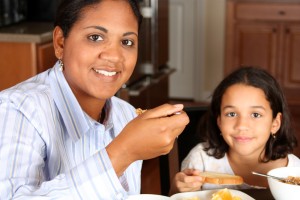Shaping positive eating behaviours
 Teaching kids positive eating behaviours during childhood can set them up with healthy eating habits for life. Developing a positive relationship with food, as well as a balanced approach to eating, can lead to better health outcomes in the long run.
Teaching kids positive eating behaviours during childhood can set them up with healthy eating habits for life. Developing a positive relationship with food, as well as a balanced approach to eating, can lead to better health outcomes in the long run.
Nowadays, an alarming 25 per cent of Australian children are being classified as overweight or obese1. This is the direct result of a number of behaviours including 1,2:
- Higher than recommended consumption of ‘occasional’ or ‘extra’ foods that are high in added fat, sugar and salt, especially fried potatoes, sugar-sweetened soft drinks, ice cream, cordials, meat pies and margarine.
- Lower than recommended consumption of fruit and vegetables.
- More food being purchased away from the home (e.g. take away).
- Evening meals being eaten in front of the television.
- In increase in screen time (iPads, TV, computers).
- A decrease in the amount of incidental activity such as walking to and from school.
- A drop in outdoor playtime.
What can parents do?
Parents often underestimate their role in the development of healthy eating habits. Speaking positively to your children about healthy foods and role modelling balanced eating is the first step in helping kids develop a healthy relationship with food. And remember, actions speak louder than words! Children watch, listen and learn through observation, and then follow what they see. Set your children up for life by being a positive role model and create healthy habits from the start.
How?
- Enjoy all foods in moderation.
- Don’t binge on ’occasional’ or ‘extra’ foods.
- Cook meals at home and try to encourage your children to help you. Involve your kids in the menu planning and shopping, too.
- Talk about healthy foods from the five food groups and what they do for your body. For instance, “this apple is so crunchy and delicious – it’s flesh is helping to keep me stay regular and it’s filling me up with its nutritious sweetness.” Or “these carrot sticks contain a super nutrient called beta carotene that helps my eyes stay sharp and focused. Or “this delicious glass of milk contains calcium – it helps my bones and teeth stay strong.”
- Ensure your child’s diet is balanced and contains a variety of foods from all the five food groups.
- Encourage your kids to eat a nutritious breakfast every day using foods from the five food groups.
- Encourage water instead of soft drink and or other drinks containing added sugars. Toss in lemon or lime wedges to flavour water.
- Avoid negative language around less healthy foods such as ‘bad’ or ‘fattening’. It’s not the type of food that’s bad, it’s the amount and how often the food is eaten that can be problematic. Instead, refer to these foods as “occasional” or “extra” foods and keep portion sizes small.
- Place a limit on the number of “occasional” or ‘extra’ foods eaten each week. These foods shouldn’t be eaten daily. Make sure the whole family sticks to this rule and have other, more nutritious snacks available.
- Fill your fridge and pantry with a variety of healthy foods that are easily accessible such as whole fruit, whole grain crackers with slices of reduced-fat cheese, reduced-fat yoghurt or pre-sliced veggie sticks with hummus or reduced fat cream cheese.
- Discourage eating in front of the TV or computer as this is often done mindlessly without paying attention to hunger cues and can result in the consumption of unnecessary kilojoules (energy).
- As often as possible, eat together at the dinner table and turn off the TV, even if the whole family isn’t present.
- Be mindful and listen to hunger cues. Most children are great at eating to their hunger so let your child stop eating when they don’t want anymore. Kids will eat when they’re hungry regardless of the food on offer, so always have healthy options available.
- Children start to form food likes and dislikes from an early age, so always offer variety. It may take many attempts for your child to like a new food, so don’t give up. Offer small amounts and try presenting it in a fun engaging way.
- Avoid using food as a reward or bribe, or holding back on foods as punishment. Use activities or trips to the park as alternatives.
Don’t forget about physical activity!
Being physically active is an important part of a healthy lifestyle. Here are some tips to get your family on track:
- Limit all screen time to two hours or less a day.
- Make time for your kids to play outside or be active for at least an hour every day.
- Be a role model and make physical activity a family event by going for a bush walk, playing family cricket, playing in the park or kicking a ball around.
- Start increasing incidental exercise such as walking to school or the shops, taking the stairs (not the lift), sweeping the path or doing some gardening.
- Choose “active” presents such as balls or kites to replace DVD’s, and play station games.
If you have tried and tested tips to help develop positive eating habits why not share them on our Healthy Kids Facebook page.
References
1 – Australian Institute of Health and Welfare 2012. Australia’s food & nutrition 2012. Cat. no. PHE 163. Canberra: AIHW.
2 – www.healthykids.nsw.gov.au






